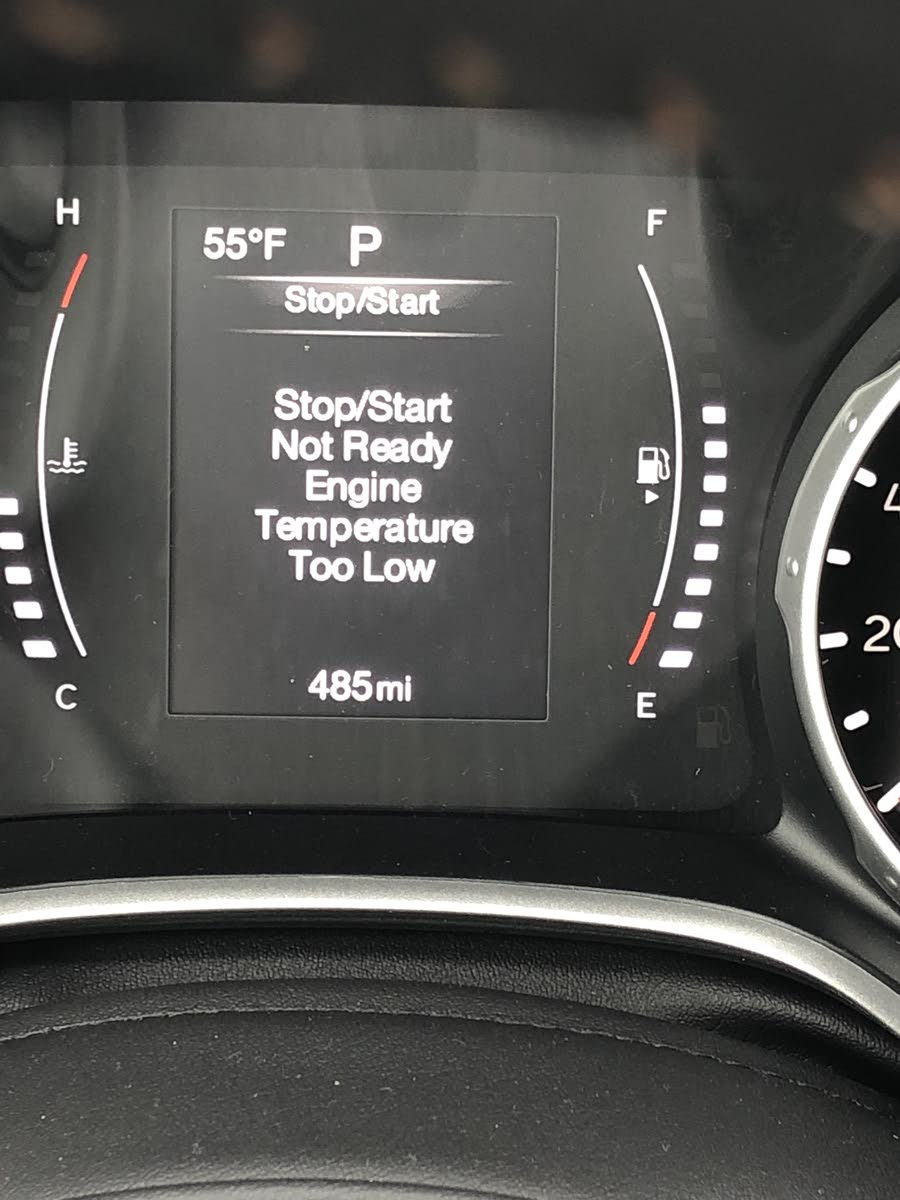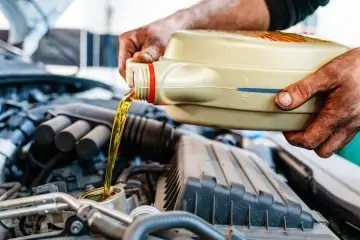The “Stop/Start Not Ready Engine Temperature Too Low” message means the engine is not warm enough for the stop/start system to function. This typically happens when the vehicle has just started or the ambient temperature is very low.
A well-functioning stop/start system can improve fuel efficiency and reduce emissions. However, if the engine temperature is too low, the system may disable itself to prevent potential damage. Cold temperatures can hinder engine performance, making it difficult for the vehicle to restart promptly.
Regularly checking the thermostat and ensuring the coolant levels are adequate can help maintain optimal engine temperature. Driving short distances frequently or in very cold weather can also affect the system’s readiness. Keeping your vehicle in good condition helps ensure all systems operate efficiently.

Credit: jeepinside.com
How Stop/start Systems Work
Stop/Start systems are designed to improve fuel efficiency and reduce emissions. These systems automatically shut down and restart the engine to minimize idling time. Understanding how these systems work can help you get the most out of your vehicle.
Basic Functionality
The primary function of a Stop/Start system is to turn off the engine when the vehicle is stationary. For example, the engine shuts off at traffic lights or during heavy traffic. Once you release the brake or press the clutch, the engine restarts automatically.
The system uses various sensors to determine when to stop and start the engine. These sensors monitor the engine’s temperature, the battery’s state of charge, and other critical parameters. If any of these conditions are not optimal, the system will not activate.
| Sensor Type | Function |
|---|---|
| Engine Temperature Sensor | Monitors engine temperature to ensure optimal performance |
| Battery Sensor | Checks the state of charge of the battery |
| Brake Pedal Sensor | Detects when the brake pedal is pressed |
| Clutch Pedal Sensor | Detects when the clutch pedal is pressed (manual transmission) |
Benefits Of Stop/start Systems
Stop/Start systems offer several benefits. Here are some of the main advantages:
- Fuel Efficiency: Reduces fuel consumption by turning off the engine during idling.
- Lower Emissions: Helps reduce CO2 and other harmful emissions.
- Reduced Engine Wear: Minimizes wear and tear on the engine by reducing idling time.
Another key benefit is the improved environmental impact. Less idling time means fewer pollutants are released into the atmosphere. This is particularly beneficial in urban areas with high traffic congestion.
By understanding how Stop/Start systems work, you can better appreciate the benefits they offer. These systems not only save fuel but also contribute to a cleaner environment.
Common Issues With Stop/start
The Stop/Start system in modern vehicles aims to improve fuel efficiency. However, several common issues can prevent it from working. Understanding these issues can help you troubleshoot and maintain your vehicle better.
Battery Temperature
The Battery Temperature plays a crucial role in the Stop/Start system. If the battery is too cold or too hot, the system may not function.
- Cold battery: The battery needs to be at an optimal temperature to provide enough power.
- Hot battery: Excessive heat can damage the battery, making it inefficient.
Maintaining the battery within the recommended temperature range is essential. Regular checks can prevent unexpected issues and ensure your Stop/Start system works properly.
Cabin Cooling Or Heating
Another critical factor is Cabin Cooling or Heating. The Stop/Start system may not activate if the cabin temperature is too high or too low.
Here are some common scenarios:
- Extreme heat: The system will keep the engine running to power the air conditioner.
- Extreme cold: The system will keep the engine running to provide heat.
Ensuring the cabin temperature is comfortable can help the Stop/Start system function efficiently. Regular maintenance of the heating and cooling system is vital.
Engine Temperature Too Low
Understanding why your engine temperature is too low is crucial. It affects your car’s performance and fuel efficiency. This section will explore the causes and symptoms of low engine temperature.
Causes Of Low Engine Temperature
Several factors can cause your engine to run at a low temperature. Here are some common causes:
- Faulty Thermostat: A malfunctioning thermostat can keep the coolant too cold.
- Coolant Issues: Low or incorrect coolant levels can impact the engine temperature.
- Cold Weather: Extremely cold weather can prevent the engine from reaching optimal temperature.
Symptoms Of Low Engine Temperature
Recognizing the symptoms can help in diagnosing low engine temperature issues. Common symptoms include:
- Poor Acceleration: The engine struggles to speed up.
- Increased Fuel Consumption: The car uses more fuel than usual.
- Temperature Gauge: The gauge shows a low reading even after the engine warms up.
Credit: www.jeepgladiatorforum.com
Impact On Vehicle Performance
When the engine temperature is too low, the vehicle’s performance is significantly affected. This can lead to various issues that compromise the driving experience and efficiency of your car. Let’s explore these impacts in detail.
Reduced Engine Performance
A cold engine struggles to deliver optimal performance. This can manifest in several ways:
- Sluggish acceleration
- Engine stuttering
- Frequent stalling
These issues occur because the engine parts are not at the ideal operating temperature. The metal components need to expand slightly to create tight seals and smooth operation. When the engine is cold, these seals aren’t tight, leading to inefficiencies and reduced power output.
Increased Fuel Consumption
A colder engine also means higher fuel consumption. Here’s why:
| Reason | Impact |
|---|---|
| Incomplete combustion | Wastes fuel and reduces efficiency |
| Longer warm-up times | Uses more fuel to reach optimal temperature |
| Increased friction | Requires more energy, hence more fuel |
When the engine is not at the right temperature, the fuel does not burn completely. This incomplete combustion leads to wasted fuel. In addition, the engine needs more fuel to warm up to its optimal running temperature, further increasing consumption.
Diagnosing The Problem
Experiencing a “Stop Start Not Ready Engine Temperature Too Low” alert can be frustrating. Understanding and diagnosing the issue is crucial for a quick resolution. Let’s dive into the steps to diagnose the problem effectively.
Checking The Thermostat
A faulty thermostat can prevent the engine from reaching its optimal temperature. This can trigger the “engine temperature too low” warning. Here’s how you can check the thermostat:
- Locate the thermostat housing, usually connected to the upper radiator hose.
- Ensure the engine is cool before inspecting to avoid burns.
- Remove the thermostat and place it in a pot of boiling water.
- Observe if it opens. If it doesn’t, the thermostat is likely faulty and needs replacement.
Inspecting Coolant Levels
Low coolant levels can also cause the engine temperature to drop. Maintaining the right coolant levels is essential for optimal engine performance. Follow these steps to check and refill your coolant:
- Ensure the engine is completely cool to prevent burns.
- Open the hood and locate the coolant reservoir.
- Check the coolant level against the “Full” and “Low” markers on the reservoir.
- If the coolant is low, add a 50/50 mixture of antifreeze and water until it reaches the “Full” mark.
Below is a table summarizing common symptoms and their potential causes:
| Symptom | Potential Cause |
|---|---|
| Engine temperature too low | Faulty thermostat |
| Coolant level low | Coolant leakage |
| Engine struggles to warm up | Thermostat stuck open |
By following these steps, you can diagnose the issue effectively. Fixing the root cause will help get your Stop Start System back in working order.
Fixing Low Engine Temperature
The engine’s temperature is crucial for optimal performance. Low engine temperature can affect fuel efficiency and cause various issues. Fixing low engine temperature involves several steps. Here, we focus on two key methods: thermostat replacement and coolant system maintenance.
Thermostat Replacement
A faulty thermostat often causes low engine temperature. The thermostat regulates the engine’s temperature by controlling coolant flow. If it fails, the coolant stays too cold.
Steps to replace a thermostat:
- Ensure the engine is off and cool.
- Locate the thermostat housing.
- Remove the housing bolts.
- Take out the old thermostat.
- Install the new thermostat.
- Reattach the housing.
- Refill the coolant.
Always consult your car’s manual for specific instructions. Replacing the thermostat can significantly improve engine temperature regulation.
Coolant System Maintenance
Regular maintenance of the coolant system is essential. It ensures the engine runs at the right temperature. A well-maintained coolant system prevents overheating and low temperature issues.
Key maintenance tasks include:
- Checking coolant levels regularly.
- Flushing the coolant system periodically.
- Inspecting hoses and connections for leaks.
- Replacing old or contaminated coolant.
Below is a table summarizing the coolant system maintenance schedule:
| Task | Frequency |
|---|---|
| Check Coolant Level | Monthly |
| Flush Coolant System | Every 2 years |
| Inspect Hoses | Every 6 months |
| Replace Coolant | Every 5 years |
Regular coolant system maintenance helps in avoiding engine temperature issues. It keeps your engine running efficiently and prolongs its lifespan.
Preventive Measures
Preventing the issue of “Stop Start Not Ready Engine Temperature Too Low” is crucial. It ensures your car runs smoothly. Following preventive measures will help maintain your vehicle’s health.
Regular Maintenance Tips
Regular maintenance keeps your engine in good condition. Follow these tips to avoid low engine temperature:
- Check Coolant Levels: Ensure the coolant is always at the right level.
- Inspect Thermostat: A faulty thermostat can cause low engine temperature.
- Oil Changes: Change oil regularly to keep the engine running smoothly.
- Battery Health: A weak battery can affect engine temperature.
Monitoring Engine Temperature
Monitoring your engine’s temperature helps prevent issues. Here’s how you can keep an eye on it:
- Use the Dashboard Gauge: Regularly check the engine temperature gauge.
- Listen for Warning Lights: Pay attention to warning lights on the dashboard.
- Feel the Hood: A quick check by feeling the hood can indicate if something’s wrong.
Maintaining and monitoring your engine can prevent “Stop Start Not Ready” issues. These simple steps will keep your car running efficiently.

Credit: www.cargurus.com
Frequently Asked Questions
What Does It Mean When It Says Engine Temperature Is Too Low?
“Engine temperature too low” indicates the engine hasn’t reached its optimal operating temperature. This can affect performance and fuel efficiency.
Is It Bad To Drive With Low Engine Temperature?
Yes, driving with low engine temperature is bad. It can reduce engine performance and increase fuel consumption.
How To Fix Low Coolant Temperature?
Check the coolant level and refill if low. Replace a faulty thermostat. Consult a mechanic if issues persist.
Why Is My Car Temperature Gauge Low?
A low car temperature gauge often indicates a stuck open thermostat or a broken temperature gauge. Check both components.
Conclusion
Understanding the reasons behind your “Stop Start Not Ready Engine Temperature Too Low” warning is crucial for vehicle health. Regular maintenance can prevent these issues and ensure optimal performance. Keep an eye on your thermostat and coolant levels. Addressing these concerns promptly can enhance your driving experience and vehicle longevity.
Stay informed and drive safely!

